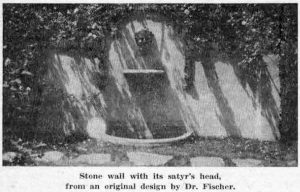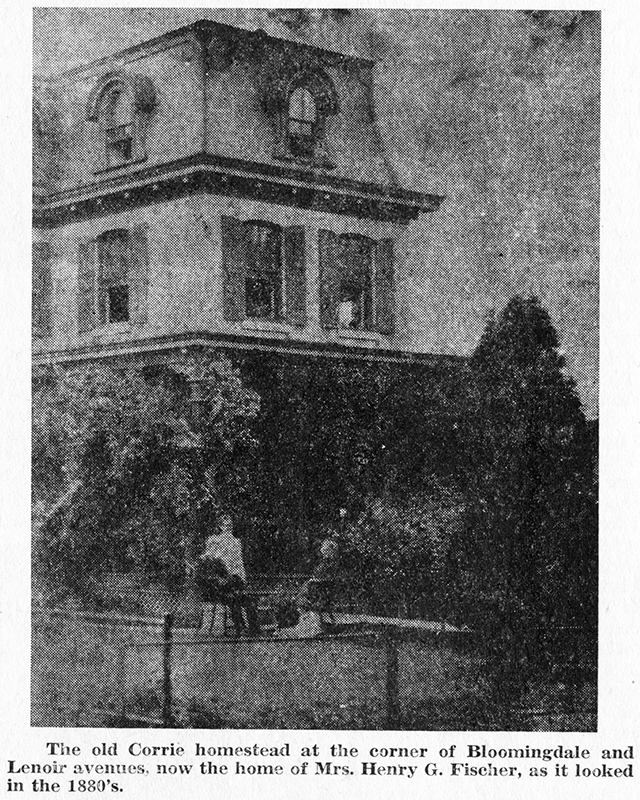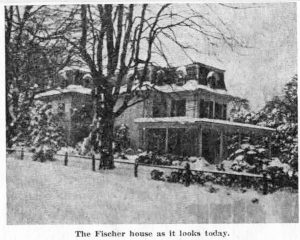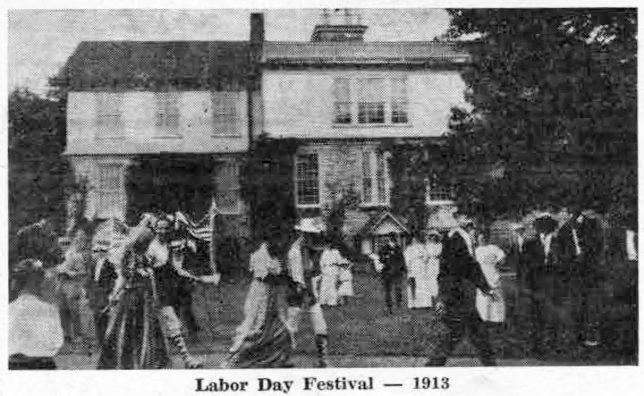The extensive rose gardens shown in the top picture grew from a small planting of bushes already on the old Eldredge property, on the north-west corner of Bloomingdale and Lenoir avenues, when the Fischers purchased it from the Charles T. Mathers more than 30 years ago. The gardens grew, bit-by-bit, under the thoughtful planning of the late Dr. Fischer, of whom his wife says, “He always beautified everything he touched.”
From the small beginning which was their heritage from former owners, the Fischers developed two long rows of bushes which extend almost the complete length of their deep lot on the north side of the house. Just visible in this first picture is the wall which is shown in more detail in the second picture published today.
Made of stone and framed with old brick, grown mossy with the passing of years, the wall has in its upper center a satyr’s hand, carved by Dr. Fischer from a design of his own. Gifted in art in its various forms, he studied painting under Thomas Eakins at the Philadelphia Academy of Fine Arts. His skill in sculpturing was self-taught, however, and his work in various art media became “a wonderful hobby for him when the garden was asleep in winter,” Mrs. Fischer tells us.
As Mrs. Fischer and the writer stood in the midst of the lovely roses late in May, our voices did not in the least disturb the birds who came to the fountains and bird baths. Here can be seen woodpeckers, cardinals, thrushes, robins and many others, in addition to the ever-present sparrows and starlings. In winter small chickadees join the ranks of feathered visitors.
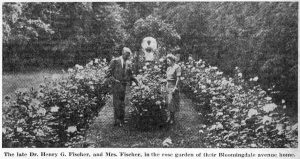 Although the adjoining picture suggests the luxurious mass of bloom as it appears in late May and early June, it can only leave to the imagination the glorious coloring. There is the red of “Crimson Glory” and “Etoile de Hollande,” the pure yellow of “Golden Dawn” and “Eclipse,” the pinks of “The Doctor” (named for Dr. Horace McFarland) and of “Pink Dawn,” and the varying tints of “Condessa de Sastago,” “Angelo Mateo” and “Madame Henri Guillot,” to name but a few of the varieties with their infinite shadings.
Although the adjoining picture suggests the luxurious mass of bloom as it appears in late May and early June, it can only leave to the imagination the glorious coloring. There is the red of “Crimson Glory” and “Etoile de Hollande,” the pure yellow of “Golden Dawn” and “Eclipse,” the pinks of “The Doctor” (named for Dr. Horace McFarland) and of “Pink Dawn,” and the varying tints of “Condessa de Sastago,” “Angelo Mateo” and “Madame Henri Guillot,” to name but a few of the varieties with their infinite shadings.
Leaving the rose garden on this afternoon in May, Mrs. Fischer took your columnist to other parts of the grounds. Behind the stone wall is a picnic spot with small wooded paths, fireplaces, rustic tables and benches, all in cool shade for, while Dr. Fischer has removed some trees, there are still many left, and there are always birds in the large pool, in what Mrs. Fischer calls the “spring garden.”
Here the “Duchess of Wellington” rose bush, a rare species of yellow bloom, may well be called her particular pride; there are also yellow pansies and blue forget-me-nots, although white flowers predominate. On this particular May afternoon, a gentle wind made a lovely blending of color against the glossy green of rhododendron and laurel.
Dr. Fischer was much concerned in the growth and development of both the Wayne Art Center and the Garden Club; in the annual exhibition of the latter his flowers were always prominently shown. In looking back over the story of the Art Center as written several years ago in these columns, it is interesting to read that “in June 1933, came the first garden party of the many that were to be sponsored by the Wayne Art Center. It was held in the garden of Dr. Fischer and of Mrs. Fischer… the party featured an outdoor exhibition of the work of students in addition to its many novel features of entertainment… these affairs came to be big summer events for children as well as adults… they were always held on a Saturday afternoon in June.” And, while more than 20 years have elapsed since that first party, there are many who still remember that it was held in the Fischers’ gardens.

